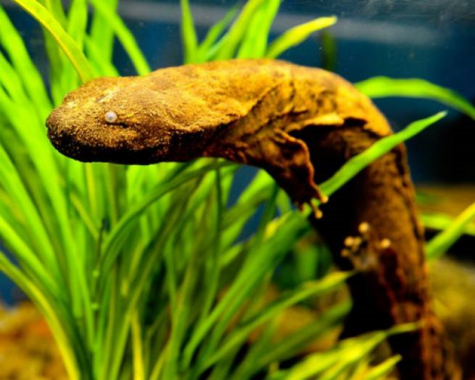Animal of the Week: The Hellbender Salamander
October 24, 2017
By Sam Schwartz ’18, Sports Section Editor
The “Animal of the Week” shows the amazing biodiversity of nature. These animals won’t be your typical wild Zebras, Sharks, and Bears-but some of the most endangered and magnificent and peculiar animals on the planet.
The Hellbender Salamander is one of the largest and rarest types of salamander on the planet. Weighing, on average, between three and a half to five pounds, and measuring up to twenty inches, Hellbender salamanders are second in size only to their Chinese cousins the Giant Salamander (Andrias davidianus), who reach lengths of nearly four feet. The reason I focus on Hellbenders, instead of the Giant Salamander, is because they are the largest indigenous species of salamander in North America, and are indigenous to Ohio. Besides Ohio, these behemoths are found throughout the Appalachians and through upstate New York. It is believed that their range at one point was the entire Midwest, but, due to their sensitivity to water pollution caused by human encroachment, their populations have suffered greatly.
Hellbenders have similar features with the rest of their salamanders, but their most defining features is their  flattened bodies. This adaptation allows them to wiggle and hide under flat rocks in creeks, as they wait to ambush their prey. Due to their poorly developed lungs, Hellbenders require highly oxygenated bodies of water. This means that Hellbenders can only live in fast moving streams and rivers. They cannot live in lakes or large slow-moving bodies of water, as they wouldn’t receive enough oxygen through their gills. Hellbenders are habitat specialists who have adapted so specifically to their environment that it is extremely difficult for them to adapt to rapidly changing conditions such as climate change or human encroachment. Dams have played a significant part in the dwindling of the Hellbender’s population, as they limit the flow of the river and deprive it of its rich oxygenation that the Hellbenders need to survive.
flattened bodies. This adaptation allows them to wiggle and hide under flat rocks in creeks, as they wait to ambush their prey. Due to their poorly developed lungs, Hellbenders require highly oxygenated bodies of water. This means that Hellbenders can only live in fast moving streams and rivers. They cannot live in lakes or large slow-moving bodies of water, as they wouldn’t receive enough oxygen through their gills. Hellbenders are habitat specialists who have adapted so specifically to their environment that it is extremely difficult for them to adapt to rapidly changing conditions such as climate change or human encroachment. Dams have played a significant part in the dwindling of the Hellbender’s population, as they limit the flow of the river and deprive it of its rich oxygenation that the Hellbenders need to survive.
Hellbenders, once they find a suitable rock, don’t stray far from it during the year, unless they are breeding. Hellbenders are predominantly nocturnal or crepuscular (most active during dawn and dusk), moving only to hunt for their prey, such as crayfish and small fish. Hellbenders live solitary lives so tracking down a partner of the opposite sex can be difficult. But once two Hellbenders find each other, the females lay nearly 150-200 eggs over a period of days. Males have been observed, if they discover a clutch of competitor’s eggs, to be cannibals and eat Hellbender eggs.
Unfortunately, Hellbenders, like many other amazing, but rarely talked about creatures, are being pushed toward the brink of extinction by human activities. Since 1980, scientists have seen a forty percent decrease in adult Hellbenders. But there is hope. According to National Geographic, there are multiple breeding programs occurring at zoos across the country. But as the current administration relaxes environment policies, specifically allowing more chemicals to be dumped into rivers and streams, wild Hellbenders will continue to suffer.



